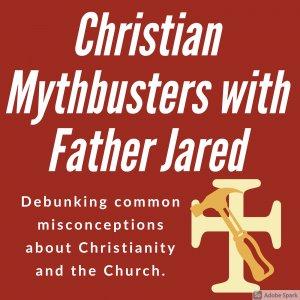Christian Mythbusters

Christian Mythbusters: Jesus Was Not a White European Man
This is Father Jared Cramer from St. John’s Episcopal Church in Grand Haven, Michigan, here with today’s edition of Christian Mythbusters, a regular segment I offer to counter some common misconceptions about the Christian faith.
For centuries, if you walked into a church in the West, you’d likely see stained glass or paintings of Jesus with pale skin, flowing light-brown or even blond hair, and blue or hazel eyes. He might look more like a Renaissance prince than a peasant from the Galilee. Those images have shaped the imagination of countless Christians, sometimes so deeply that people even get defensive if you suggest Jesus might have looked different.
But here’s the truth: Jesus was a first-century, Middle Eastern Jewish man. He was born in Bethlehem and raised in Nazareth, in the rugged land of Palestine under Roman occupation. His skin would not have been pale. His eyes and hair would not have been light. He looked like a Galilean Jew of his time: brown-skinned, dark-haired, Semitic features.
So this week we’re breaking the myth that Jesus was a white, European-looking man.
Why does this matter? Isn’t it just about art and symbolism? Well, it matters because how we picture Jesus shapes how we understand God. If we only ever see Jesus as white and European, we are subtly—sometimes not so subtly—encouraged to equate God with whiteness and Europeanness. And that has real consequences. It has reinforced systems of colonialism, racism, and exclusion. It has allowed Christians to imagine themselves in the image of God while marginalizing those who look different.
This isn’t just about history; it’s about justice. Think about what is happening right now in our world. The war between Israel and Gaza continues to devastate lives, with brown-skinned men, women, and children paying the heaviest price. Here in our own nation, racial profiling continues to plague people of color. For a while now, it has been those who look Middle Eastern, Arab, or Muslim. Most recently it’s been explicitly allowed for people who are Latinx—even though Jesus himself would likely be mistaken for any of those by modern security officers. To insist on a white Jesus in this context isn’t just inaccurate; it is spiritually dangerous. It erases the real human identity of the God who became flesh and aligns him instead with systems of power he came to overturn.
Scripture itself reminds us that God’s choice to become incarnate was not arbitrary. Jesus came into the world as part of a marginalized people, subject to the suspicion of empire and the oppression of the powerful. He lived under Roman occupation. He and his family fled as refugees to Egypt to escape violence. The one we follow knew the vulnerability of being brown and Jewish in a world dominated by whitened imperial ideals.
Representation matters because it opens our eyes to where God is at work today. When we picture Jesus only as white, we risk overlooking him in the very places he promised to be found—in the poor, the stranger, the prisoner, the oppressed. But when we remember Jesus’ true Middle Eastern Jewish identity, it becomes harder to separate our love for Christ from our solidarity with those who suffer under racism, war, and exclusion today.
Breaking the myth of a white Jesus does not mean rejecting the art of past centuries. But it does mean being honest about its limitations and refusing to let it shape our theology uncritically. We can still value those cultural depictions while also lifting up new images—icons, art, stained glass—that show Jesus as the Middle Eastern Jew he truly was. Doing so is not about political correctness. It’s about theological faithfulness. It’s about remembering that God’s incarnation was not in the image of empire, but in the body of a people pushed to the margins.
Thanks for being with me. To find out more about my parish, you can go to sjegh.com. Until next time, remember, protest like Jesus, love recklessly, and live your faith out in a community that accepts you but also challenges you to be better tomorrow than you are today.






 Visit Podcast Website
Visit Podcast Website RSS Podcast Feed
RSS Podcast Feed Subscribe
Subscribe
 Add to MyCast
Add to MyCast